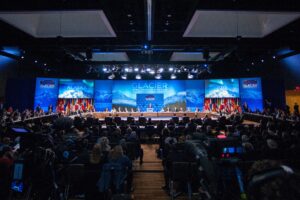United States
Facts & Figures
AC member since 1996
Active Polar Icebreakers
2
Coordinates
Washington, D.C.: 38.9072° N, 77.0369° W
Juneau, AK: 58.3019° N, 134.4197° W
Population
United States: 329.1 million
Alaska: 736,000
Land Area
United States: 9.857 million km2
Alaska: 1.718 million km2
Coastline
1,706 km
- Environment
- People
- Economy
- Arctic Policy
- Recent Publications
- Links
- Experts
The United States is an Arctic nation and privy to northern regional governance and policy decisions through its 49th state, Alaska. Purchased from the Russian Empire in 1867 for $7.2 million USD, the Territory of Alaska entered into statehood in 1959. As part of the continental, but not contiguous United States, Alaska is bordered by the Canadian Yukon Territory to the east and the Canadian province of British Columbia to the southeast. To the north lie the Chukchi and Beaufort Seas and the southern waters of the Arctic Ocean. To the west and south lie the Pacific Ocean, with Russia further west across the Bering Strait. Altogether, Alaska has more than 34,000 miles of coastline. Though it is the largest state in the union, it is the least densely populated, with over half of all residents living in two cities – Anchorage and Fairbanks.
Although research like the Arctic Human Development Report considers all of Alaska to be Arctic, Arctic Alaska commonly includes the North Slope Borough, the Northwest Arctic Borough, and the Nome Census area. Larger towns include Prudhoe Bay, Barrow, Kotzebue, Nome, and Galena. The average annual high and low for Barrow are -8.2 °C (17.2 °F) and -14 °C (6.4 °F), respectively. There are very few roads in the Alaskan Arctic, and many rural communities can only be accessed by aircraft or snowmobile in good weather. Northern Alaska largely consists of tundra covering mountain ranges, permafrost, and coastal plains that provide habitat to bears, wolves, Dall sheep, muskoxen, reindeer, and many birds. The Gates of the Arctic National Park and the Arctic National Wildlife Refuge, both of which are fully and partially protected by federal law, help to preserve Alaska’s natural landscapes.
Alaska has been host to a number of high political and media profile environmental issues over the past five decades concerning tensions between natural resource extraction and environmental protection. The debate to permit drilling for oil in the Arctic National Wildlife Refuge (ANWR) has been an ongoing controversy since 1977. ANWR, a 19,300,000 acre refuge, is the largest protected wilderness in the US. ANWR’s Coastal Plain, also known as the “1002 Area” is rich in petroleum and natural gas deposits, though the amount of economically recoverable oil is debated. The key issue of oil exploration in the Refuge is the potential disturbance to wildlife, particularly the Porcupine Caribou that calve on the Coastal Plain and migrate through the Refuge from Alaska to Canada each year. In 2015, President Obama proposed to declare an additional 5 million acres of the Refuge as a wilderness area, which would put a total of 12.8 million acres of the refuge permanently off-limits to drilling or other development. In December 2017, a Republican-led Congress voted to lift the 40-year-old ban on energy development in ANWR. The decision came through a provision embedded within a larger tax bill mandating that the US Department of the Interior hold lease sales in the “1002 area.” The Department of the Interior has stated that it will move forward with ANWR lease sales in 2019, though legal battles are expected.
The Exxon Valdez Oil Spill has left a long, dark legacy on the narrative of oil exploration and environmental protection in the Arctic. On March 24, 1989, the Exxon Valdez oil tanker struck Prince William Sound’s Bligh Reef and spilled approximately 10.8 million gallons (37,000 metric tonnes) of crude oil over the next several days. The response was particularly difficult because Prince William Sound’s remote location is only accessible by helicopter, plane, or boat. The immediate effects of the spill include as many as 250,000 seabirds, at least 2,800 sea otters, 22 orcas, and an unknown number of fish deaths. Though most wildlife has recovered from the spill as of 2020, orca whales have yet to reach pre-spill levels, and an estimated 16,000 to 21,000 gallons of oil remain on beaches. Still today, there is significant concern over Arctic oil spills from activist groups, local communities, and environmentalists at large, as seen most recently by protests against Shell’s now terminated Arctic drilling campaign.
Pebble Mine, on public land in the Bristol Bay area of southwest Alaska, has been among the largest environmental concerns in Alaska in recent years. The proposed copper, gold, and molybdenum mine would be the largest open-pit mine in North America at two miles wide and over 2,000 feet deep. If developed, the mine poses serious risks of contaminating the watershed, salmon, and other fisheries with mine-generated pollutants such as heavy metals and acid mine drainage. In 2014, the EPA openly questioned the future of the salmon habitat should the mine open and proposed restrictions that would effectively prohibit the project from moving forward. This was followed by the Obama Administration’s decision to initiate a 404(c) action under the Federal Clean Water Act, authorizing the EPA “to prohibit, restrict, or deny the discharge of dredged or fill material at defined sites in waters of the United States… whenever it determines, after notice and opportunity for public hearing, that use of such sites for disposal would have an unacceptable adverse impact on one or more of various resources, including fishers.” Although this action has stalled the mine and caused the development to lose several investors, the US Army Corps of Engineers has gone against the 404(c) decision and begun an Environmental Impact Assessment for the mine’s development. In November 2018, Alaska voters will decide the balance between resource development and salmon habitat protections. Ballot Measure 1, Salmon Habitat Protections and Permits Initiative would implement new requirements and processes for permit applications, reviews, and granting of permits for any project affecting bodies of water related to anadromous fish — virtually killing the economic viability of Pebble Mine.
Alaska’s Arctic, like the rest of the region, is facing warming at twice the rate of the rest of the globe. Higher temperatures create dangerous ice conditions; decrease the quantity and quality of annual snowfall; change weather patterns; and shift landscapes as permafrost thaws—all of which seriously undermine ecosystem and wildlife integrity.
This page was updated on 1 August 2022. If we have missed anything, please contact info@thearcticinstitute.org.


